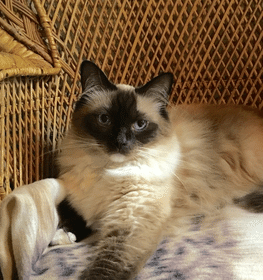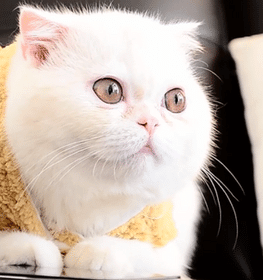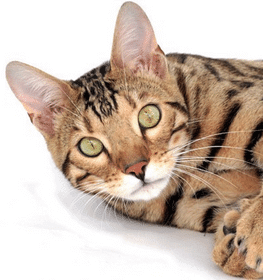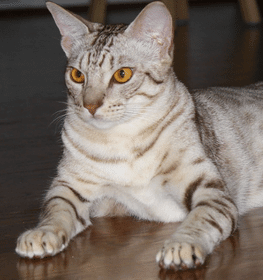Himalayan Cat Breed Information and Facts
This page is about the Himalayan cat breed information and what it means to own one as a companion animal. If you are considering getting Himalayan cat breed, this profile will be helpful in deciding whether or not they are right for you!
| Group | Crossbreed |
|---|---|
| Popularity Rank | 33 |
| Reviews | 0 |
| User Ratings | |
|
Compare the Himalayan With Other Cats
Select at least one cat breed to make the comparsion. | |
 | |
| Origin | |
|
Other Names
What other names are there for the Himalayan cat? | Himalayan Persian, Colourpoint Persian, Longhaired Colourpoint, Himmy |
|---|---|
|
Price
What is the cost of a Himalayan cat? | $1000 to $2500 If you choose to purchase the Himalayan cat, you should know that the mentioned amount of money is an average of the collected data from breeders’ sites and cat finder places. If you have a Himalayan cat for sale, please advertise it on a reliable website to make sure the Himalayan gets to a happy place. |
| Cost Of Ownership | High |
| Breed Recognition | The International Cat Association (TICA)Cat Fanciers' Association (CFA) |
|
Size
How big is a Himalayan cat? | Medium The medium-sized cats usually weigh 10-15 pounds and are 8-11 inches long from the nose down. |
|---|---|
|
Weight
What is the weight of the Himalayan cat? | Male: 9 - 14 pounds, Female: 7 - 11 pounds |
| Bite Force | Average Bite Strength: Around 10-15 PSI An average cat bite strength, usually ranging from 10-15 PSI, is commonly observed in medium-sized cat breeds such as the Himalayan or those with moderate jaw muscle development. While these cats possess a stronger bite compared to smaller breeds, ensuring proper socialization and comprehending feline body language remain crucial to avoid biting incidents. Cat owners investigating average bite strength in cats, medium bite force breeds, or specific breeds like the Himalayan will find this category informative and useful. |
| Body Type | Cobby This body type is a mix between the cobby and foreign types. Himalayan are muscular but not as broad as cobby cats and not as slender as foreign cats. Examples include the Ragdoll and American Shorthair. |
| Ear Shape | MediumRoundedWide-set |
| Eye Color | Blue |
| Hair Color and Pattern | Colorpoint patternBase coat is cream or fawn with coloured points on ears, face, paws, and tailPoint colours include seal, blue, chocolate, lilac, red, and cream, as well as lynx (tabby) and tortie patterns. |
|
Coat
What kind of coat does the Himalayan cat have? | Long |
| Leg Lenght | Medium |
| Whisker Length | Medium |
| Musculature | Solid |
| Head Shape | Round |
| Toe Count | 5 front4 back |
| Eye Shape And Orientation | Round |
| Night Vision | |
| Paw Size | Medium |
| Nose Structure | Short and Broad |
| Neck Length | Medium |
| Fur Texture | ShortDense |
| Bone Density | Medium |
| Flexibility | High |
| Bone Structure | Robust |
| Tail Length | Plumed |
| Sleep Patterns | Moderate Sleep |
| Attention Span | Short to moderate, relaxed and gentle |
|---|---|
| Guarding Instinct | Low |
| Protection Instincts | Low |
| Climbing Ability | Low |
| Jumping Ability | Moderate |
| Swimming Ability | Poor |
| Water Affinity | |
| Rescue Capability | Poor |
| Litter Size | 2-4 Kittens |
|---|---|
| Special Needs | AffectionateHigh grooming |
| Breeding | Requires grooming knowledge, small to moderate litter size |
| Dietary Preferences | Balanced diet |
| Solo Time Tolerance | Low |
| Noise Sensitivity | Moderate |
| Genetic Diversity | Low |
| Sensitivity To Changes | Medium sensitivity |
| Food Motivation | Low |
| Feeding Schedule | Twice a dayMorning and Evening |
| Maintenance Level | Moderate |
| Exercise Needs | Medium |
|
Life Expectancy
What is the life expectancy of the Himalayan cats? | 9-15 years |
|
Energy Level
How energetic is the Himalayan cat? | The Himalayan cat has a low energy level. |
|
Hypoallergenic
Are Himalayan cats hypoallergenic? | No Himalayan cats don't do well with allergy sufferers by causing an allergic reaction. Some of the cat breeds are even considered to higher possibility of an allergic response.
Coat type isn't necessarily relevant, because most people are allergic to dander (flakes on the cat's skin) or saliva, not actually to cat hair. |
|
Common Health Issues
Are Himalayan cats a healthy breed? | High Himalayans tend to have more frequent health issues than other breeds. Regular vet check-ups are needed. |
| Health Problems | Progressive Retinal Atrophy (PRA)Polycystic Kidney Disease (PKD)Brachycephalic Airway Syndrome |
| Climate | Temperate |
| Cold Tolerance | Medium |
| Heat Tolerance | Medium |
| Breeding Difficulty | Medium |
| Common Vocalizations | Soft and infrequent meows |
|---|---|
| Interaction With Other Pets | Good, calm and gentle |
| Facial Expression | Sweet and gentle |
| Tail Behavior | Sweet and gentle tail movements |
| Explorer Instincts | Low |
| Attention Needs | Low |
| Protectiveness | Low |
| Territoriality | Low |
| Independence | Low |
| Response To Commands | Low |
| Adaptability To Indoor Life | High |
| Hunting Drive | Low |
| Play Style | PlayfulGentleCalm |
| Escape Tendencies | Low |
| Curiosity | Low |
| Hunting Skills | Moderate ⏺️ |
| Reaction To Strangers | Cautious |
| Stalking Behavior | Low |
| Aggression Level | Moderate |
| Training Difficulty | Difficult |
| Agility | Low |
| Travel Compatibility | Medium |
| Activity | Moderately Active |
| Compatibility With Other Animals | PlayfulMedium |
| Household Noise Tolerance | Medium |
| Playfulness | Balanced Playmate. Himalayan have a balanced playfulness. They enjoy playing with toys and interacting with their owners but also appreciate downtime. |
|
Trainability
Are Himalayan cats easy to train? How hard is it to train a Himalayan? | Average Trainability: Himalayan cat breeds are less interested in training and obedience, but can still learn basic commands and routines with enough practice and rewards. Examples of average trainable cat breeds include Persian, Russian Blue, and British Shorthair. |
|
Lap Cat
Are Himalayan cats lap cats? | Yes This cat loves to sit on his owner's lap. |
|
Temperament
What personality do Himalayan cats have? | Dependent |
|
Adaptability
Are Ragdoll cats adaptable? | Himalayan cats adapt very well to lifestyle changes and basically all living environments. They don't mind moving from one place to another with their owner. |
|
Affection Level
Are Himalayan cats more affectionate? | High: Himalayan cats are genuinely loyal, soft and gentle, loving and affectionate cats toward their handlers. They enjoy quality time with their owners despite the activity and are considered great therapy cats for those in need. |
|
Child Friendly
Are Himalayan cats good with kids? | The Himalayan cat is a child-friendly breed. This breed is a good choice if you have children. |
|
Dog Friendly
Are Himalayan cats good with dogs? | Himalayan cats are not the most dog-friendly breed. |
|
Intelligence
Are Himalayan cats intelligent? Are Himalayan cats smart? | Average: the Himalayan cat has an average level of intelligence. |
|
Social Needs
Are Himalayan cats social? | Above-average: they need more social interaction than average cats. |
|
Stranger Friendly
Are Himalayan cats friendly to strangers? | Average: this cat breed gets on relatively well with strangers. |
|
Vocalization
Do Himalayan cats vocalize? | Low Low vocalization cats are a category of cats that typically make less noise than other cats. This can be due to a variety of reasons, including genetic disposition, health, or even personality. While some low vocalization cats may simply be quiet by nature, others may only meow when they are distressed or in need of attention. Low vocalization cats can make excellent pets for those who are looking for a feline companion that is relatively low maintenance in terms of noise. |
| Seasonal Shedding | High |
|---|---|
| Grooming Tools Needed | BrushNail ClipperComb |
| Dental Care | High High dental care needs cat breeds, including the Himalayan, are more susceptible to a wide array of oral health challenges due to genetic factors, distinctive skull structures, or other breed-specific features. These feline breeds necessitate more attentive and frequent dental care routines to maintain proper oral hygiene and avert dental complications. Pet owners should prioritize consistent teeth brushing, professional dental cleanings, and veterinary dental check-ups to tackle potential issues like overcrowding, misaligned teeth, gingivitis, and periodontal disease in these high-risk breeds. |
|
Grooming
How to groom your Himalayan cat? | High Maintenance This cat breed requires more time and effort than other breeds. Grooming your cat is an essential part of keeping their coat in top condition. It also allows you to control more serious problems with hygiene, if they arise!
It's important for pet owners who own Himalayan cats or other long-haired breeds to avoid underfeeding because this can cause nutritional deficiencies that could lead directly to health issues such as mange; however, there are plenty of alternatives we recommend instead including brushing often (at least twice per week), buying quality food tailored specifically towards cats. |
|
Shedding
Do Himalayan cats shed a lot? | High If you're looking for a cat that won't leave a trail of fur everywhere they go, you might want to rethink your choice of pet. While there are some breeds that shed less than others, all cats will lose some hair throughout the year. And when they do, it can be a real pain to clean up. If you're not prepared to deal with regular grooming and vacuuming, a Himalayan cat probably isn't the right pet for you. |
Himalayan Pros and Cons
Pros
- Adaptability: Himalayan cats adapt very well to lifestyle changes and basically all living environments.
- Affection Level: High: Himalayan cats are genuinely loyal, soft and gentle, loving and affectionate cats toward their handlers.
- Child Friendly: The Himalayan cat is a child-friendly breed.
Cons
- Energy Level: The Himalayan cat has a low energy level.
- Dog Friendly: Himalayan cats are not the most dog-friendly breed.




